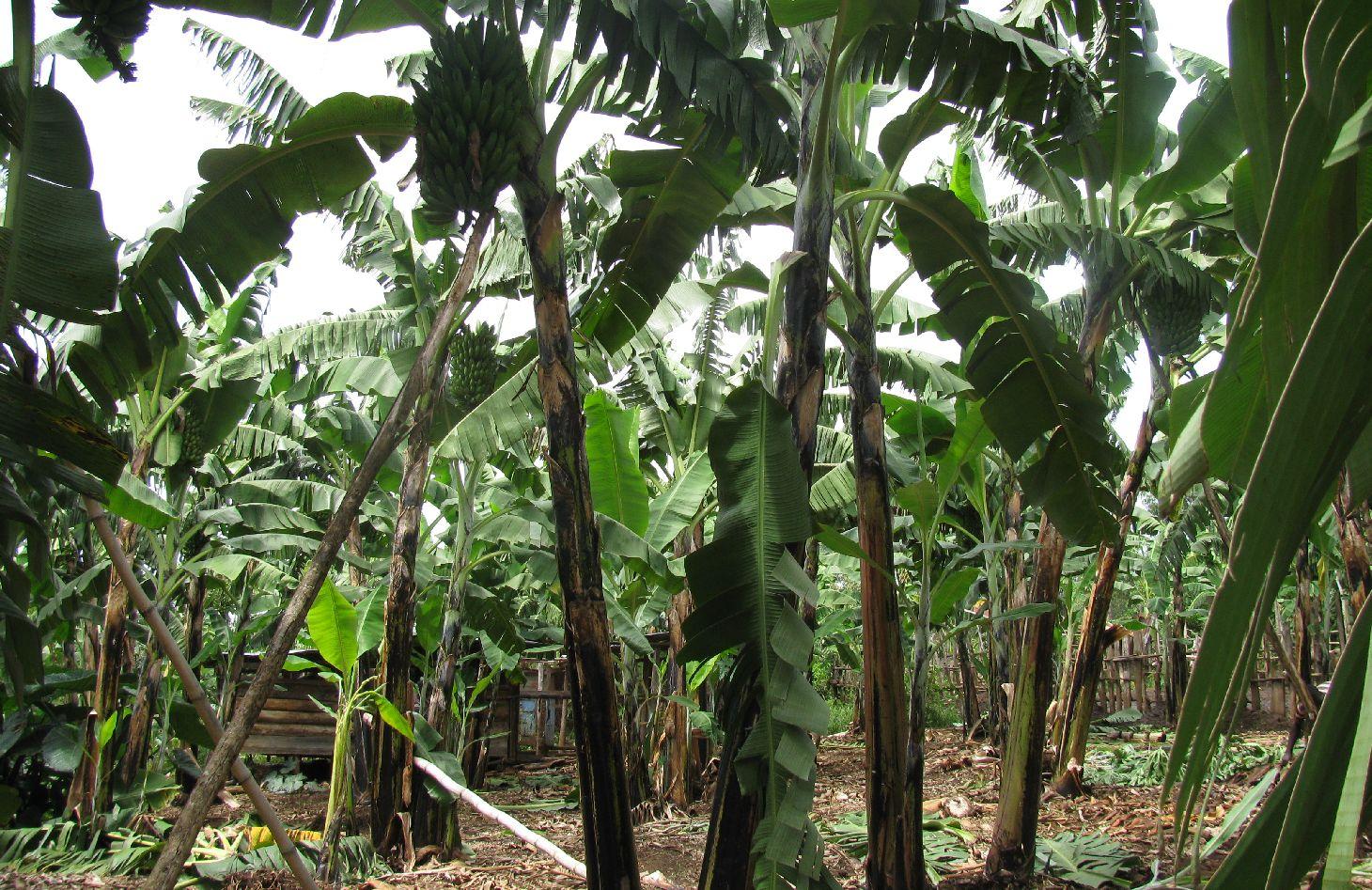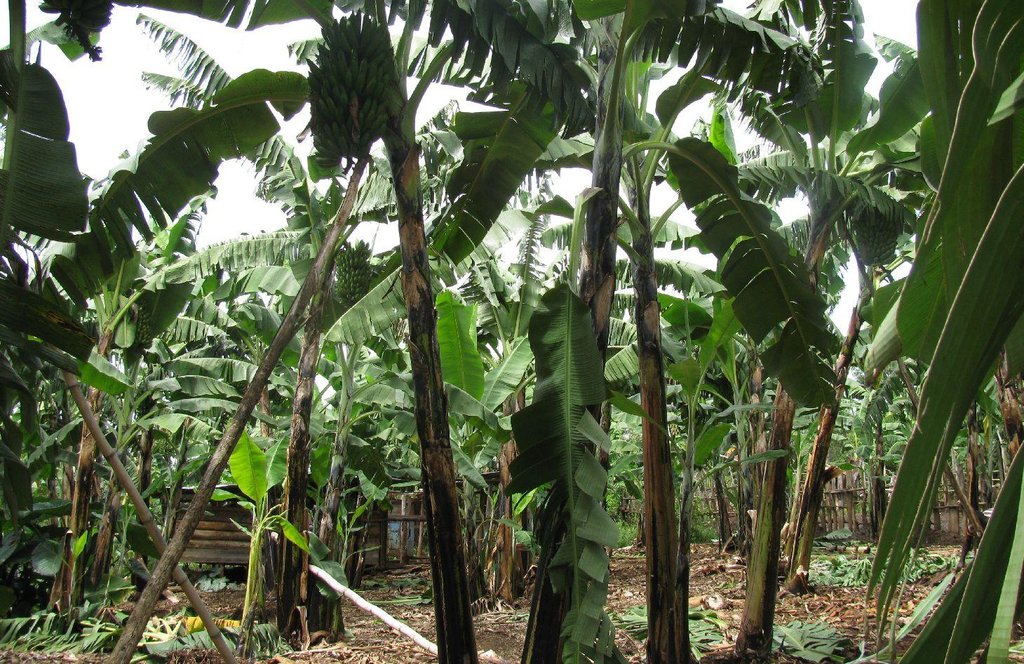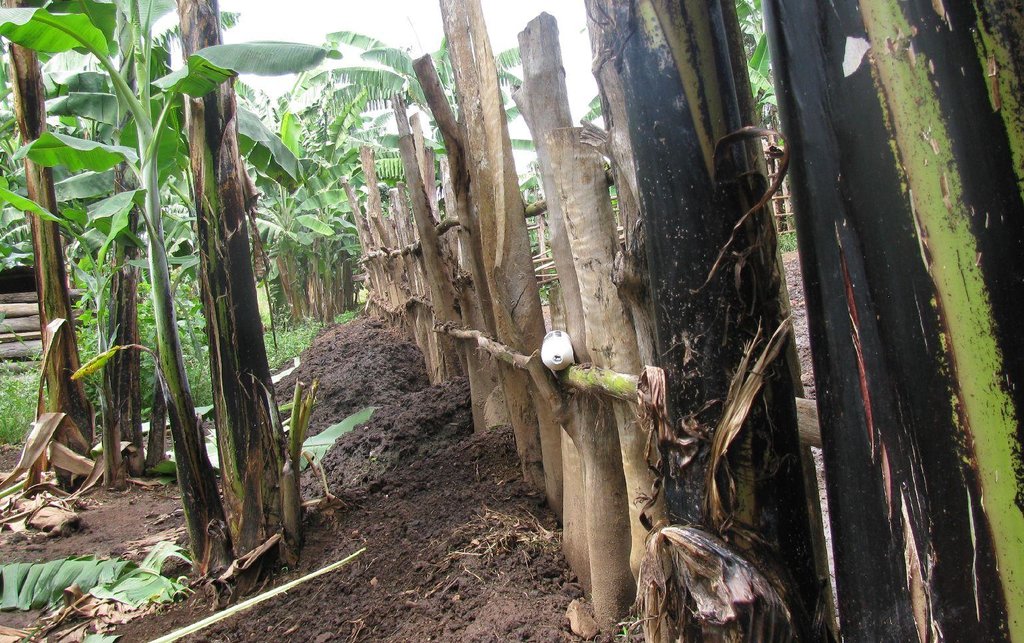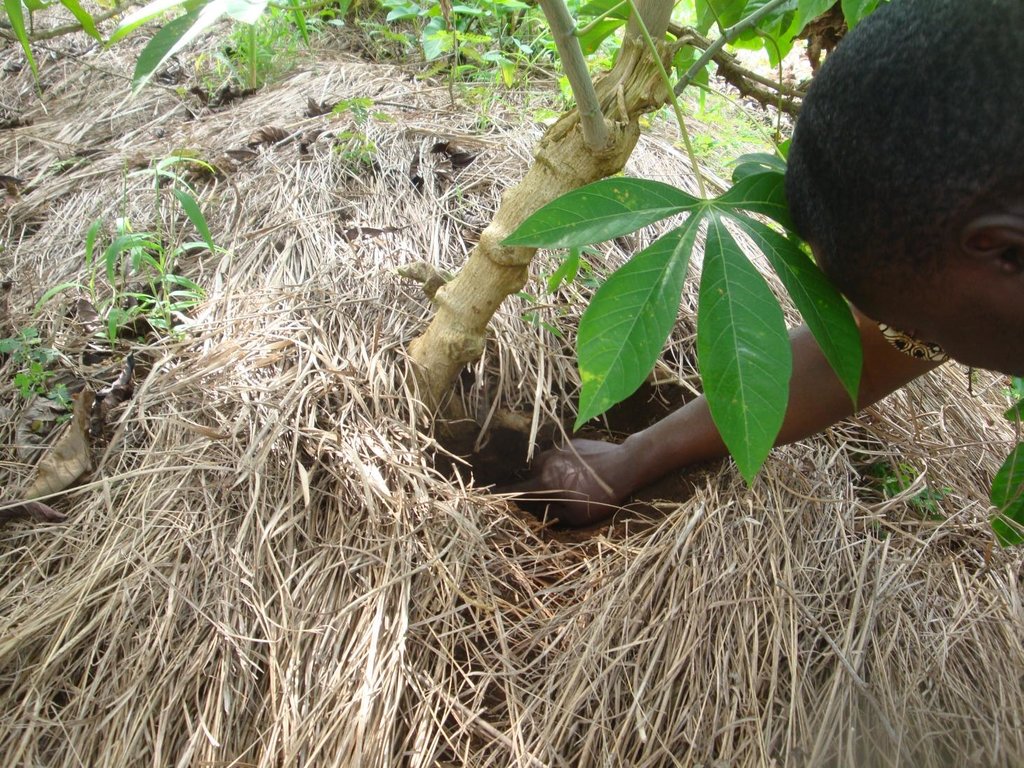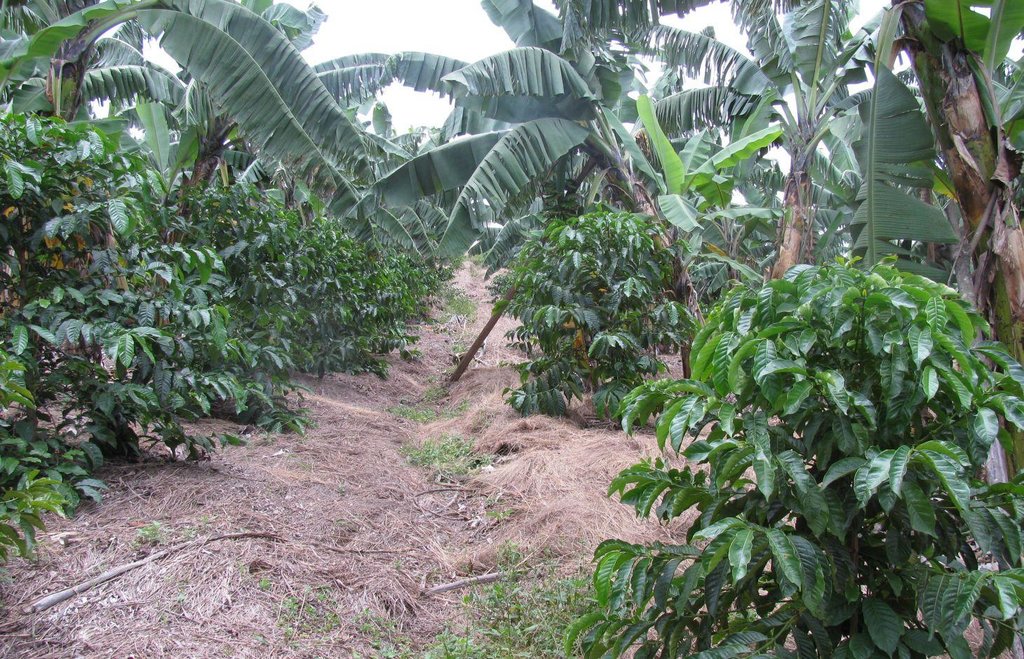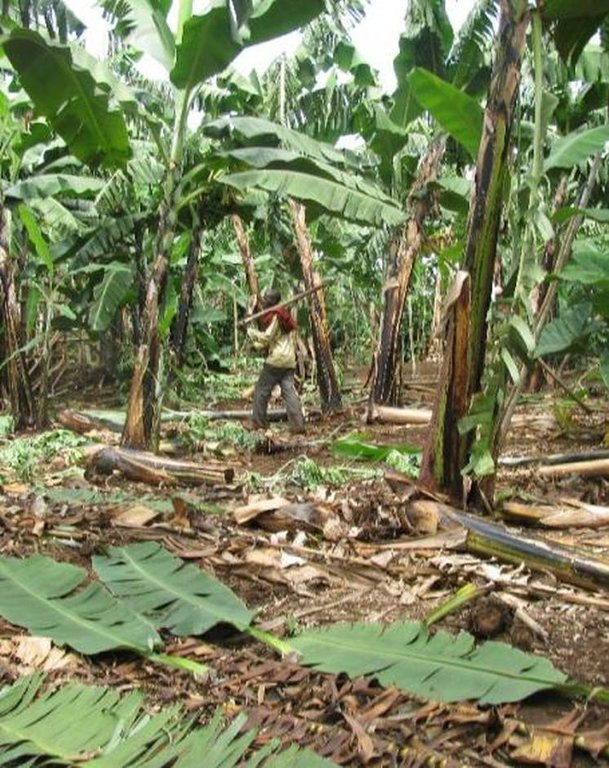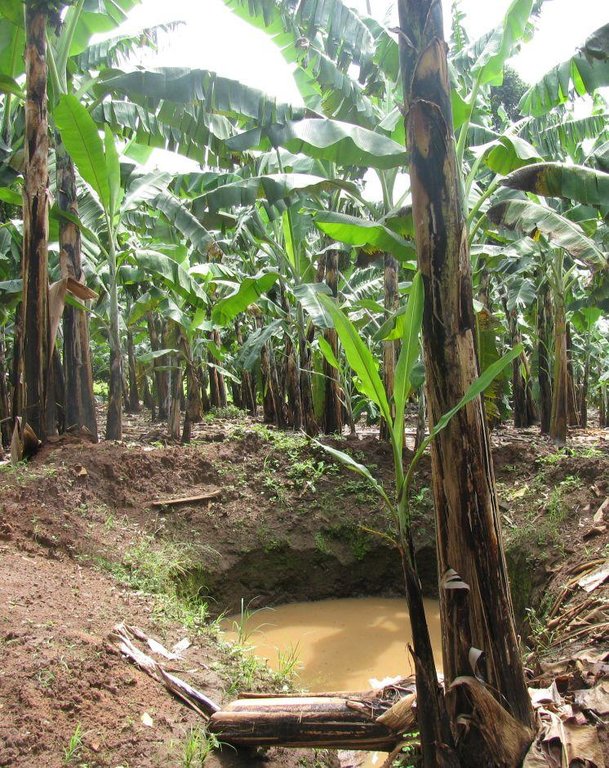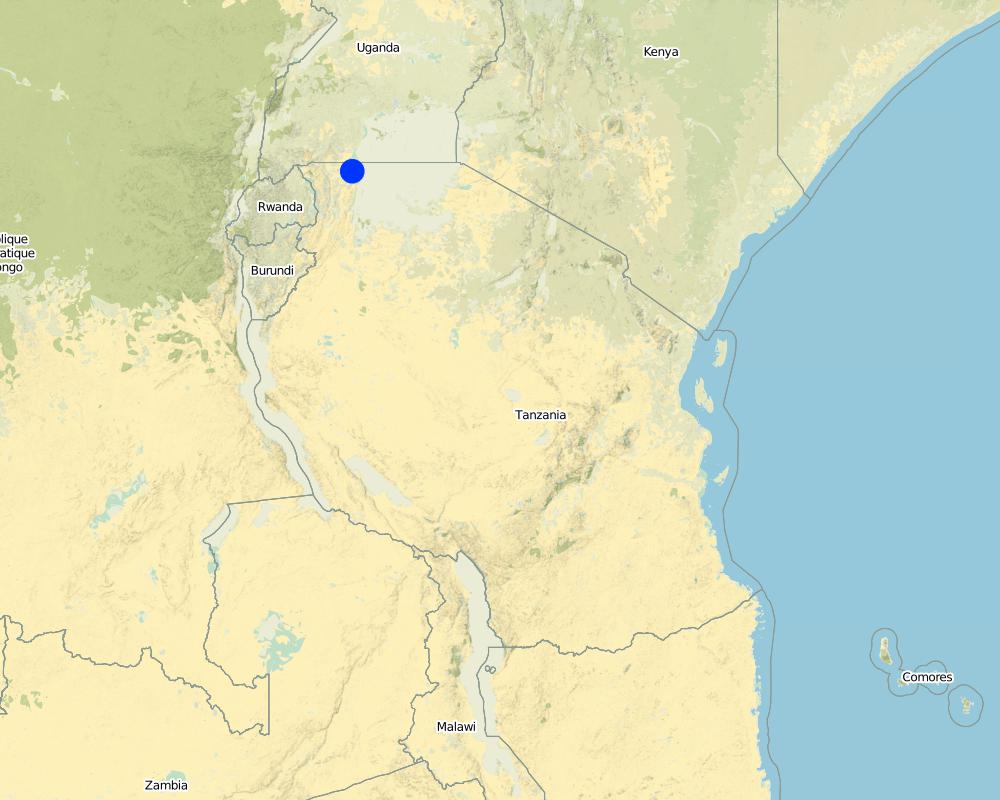Improved Kibanja cropping system [ប្រទេសតង់សានី]
- ការបង្កើត៖
- បច្ចុប្បន្នភាព
- អ្នកចងក្រង៖ Jasson Rwazo
- អ្នកកែសម្រួល៖ –
- អ្នកត្រួតពិនិត្យច្រើនទៀត៖ David Streiff, Alexandra Gavilano
Ekibanja ekiine emikolele emirungi (Haya/Nyambo)
technologies_1183 - ប្រទេសតង់សានី
ពិនិត្យមើលគ្រប់ផ្នែក
ពង្រីកមើលទាំងអស់ បង្រួមទាំងអស់1. ព័ត៌មានទូទៅ
1.2 ព័ត៌មានលម្អិតពីបុគ្គលសំខាន់ៗ និងស្ថាប័នដែលចូលរួមក្នុងការវាយតម្លៃ និងចងក្រងឯកសារនៃបច្ចេកទេស
Government:
អ្នកជំនាញឯកទេស SLM:
Government:
Makung'uto Iddi
Missenyi District Council
ប្រទេសតង់សានី
Government:
Kagaruki Anna Grace
Missenyi District Council
ប្រទេសតង់សានី
Government:
Subira John
Missenyi District Council
ប្រទេសតង់សានី
អ្នកជំនាញឯកទេស SLM:
Kaihura Fidelis
Kagera TAMP
ប្រទេសតង់សានី
Government:
Kitundu Elizabeth
Missenyi District Council
ប្រទេសតង់សានី
ឈ្មោះគម្រោងដែលបានចងក្រងឯកសារ/ វាយតម្លៃលើបច្ចេកទេស (បើទាក់ទង)
The Transboundary Agro-ecosystem Management Project for the Kagera River Basin (GEF-FAO / Kagera TAMP )ឈ្មោះអង្គភាពមួយ (ច្រើន) ដែលបានចងក្រងឯកសារ/ វាយតម្លៃបច្ចេកទេស (បើទាក់ទង)
FAO Food and Agriculture Organization (FAO Food and Agriculture Organization) - ប្រទេសអ៊ីតាលីឈ្មោះអង្គភាពមួយ (ច្រើន) ដែលបានចងក្រងឯកសារ/ វាយតម្លៃបច្ចេកទេស (បើទាក់ទង)
Missenyi District Council (Missenyi District Council) - ប្រទេសតង់សានី1.3 លក្ខខណ្ឌទាក់ទងទៅនឹងការប្រើប្រាស់ទិន្នន័យដែលបានចងក្រងតាមរយៈ វ៉ូខេត
អ្នកចងក្រង និង(បុគ្គលសំខាន់ៗ)យល់ព្រមទទួលយកនូវលក្ខខណ្ឌនានាទាក់ទងទៅនឹងការប្រើប្រាស់ទិន្នន័យដែលបានចងក្រងតាមរយៈវ៉ូខេត:
បាទ/ចា៎
1.5 ការយោងទៅលើកម្រងបញ្ជីសំណួរ (មួយ ឬច្រើន) នៃវិធីសាស្ត្រផ្សព្វផ្សាយ SLM (ដែលបានចងក្រងដោយទស្សនៈពិភពលោកស្តីពីវិធីសាស្ត្រ និងបច្ចេកទេសងអភិរក្ស WOCAT)
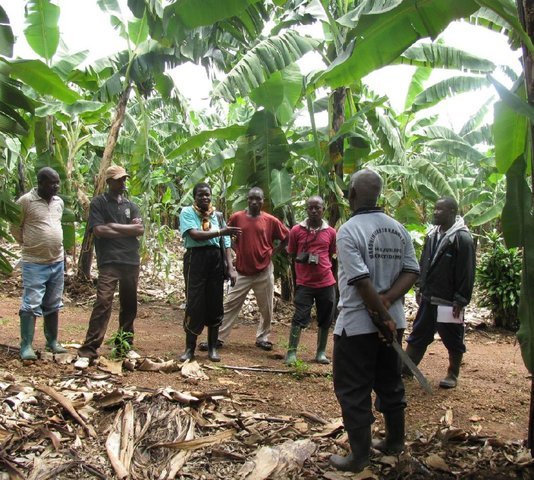
Integrated farm knowledge adoption [ប្រទេសតង់សានី]
The way and means through which a performing farmers adopt and use a combination of indigenous and scientific to maximaze production.
- អ្នកចងក្រង៖ Jasson Rwazo
2. ការពណ៌នាពីបច្ចេកទេស SLM
2.1 ការពណ៌នាដោយសង្ខេបពីបច្ចេកទេស
និយមន័យបច្ចេកទេស:
This is a traditional banana and coffee complex cropping system interplanted with annual crops, trees,shrubs, vegetables and other diverse plants of social economic importance.
2.2 ការពណ៌នាលម្អិតពីបច្ចេកទេស
ការពណ៌នា:
Improved traditional multi-cropping system that combines banana and coffee as main crops planted in a specific spacing to optimize plant stands. Banana and coffee are intercropped with; 1. annuals crops: Maize, beans, yams, coco-yams;2. Vegetables: Lycoperscum esculentum, Amaranthus spp, Cucumis communis and Solanum aethopium ;3. Shrubs of social economic value. Trees (e.g Maesopsis eminii, Makhcamia lutea, Ricinus comunis, Ficus thorninghii) and shrubs (Dracaena usambarensis) are planted on the farm edge. These serve as live fence, wind breaker, source of timber, fuel wood, medicine and protect the field against erosion. To optimize farm production, application of 15cm thick mulch ( grass mulch and banana prunnings), farmyard or compost manure and interplanting with soil fertility and/or soil moisture improvement trees are ensured. With problems of climate change, water harvesting ditches and trenches are constructed. Water harvesting ditches are constructed to collect water from micro catchments like roads or homestead. Sustainability of the Improved Kibanja system has always been assured through crop/livestock integration approaches.The cropping system is typical in high rainfall areas along foot slopes, valley bottoms or hilltops preferably on fertile and deep soils.
Purpose of the Technology: The purpose is improve soil fertility,moisture, controlling soil erosion (wind and water) and suppressing weeds in order to improve the production banana, coffee and other inter planted crops.
Establishment / maintenance activities and inputs: Establishment activities: 1. Land clearing and preparation: Slashing, uprooting tree stumps, ploughing and pitting 60cm x 90cm banana hole and 60cm x 60cm coffee (Mid June to August) using simple farm implements; 2.Farm Yard Manure application: 60 Kg per banana holes and 36 Kg per coffee hole (August to early September); 2. Planting: 308 banana suckers at 3.6m x 8m spacing, 830 coffee seedlings at 3m x 8m spacing in alternating row, edge row trees seedling at 10m spacing and 15cm spacing for shrubs e.g. Dracaena usambarensis (September to November);4. Excavation of water retention structure ( after planting mainly in Novermber). Full establishment of Improved Kibanja cropping system can be attained in three years.
Maintenance activities:1. Weeding:Done two times per year (mid January to February / July to augost) before planting annual crops; 2.FYM enrichment: Every after 3 years; iii. banana dethrashing and desuckering ,topping mulch, coffee pruning and harvesting (Immediately after weeding); 4. Other maintenence activities: Disease control (nematode, banana weevils, Banana Xanthamonas Wilt) and Propping (using pole to support banana plant with heavy bunches against wind); 5.Inputs: Labour, farmyard manure, propping poles, mulch; 6. Simple farm implements:Hand hoe,machete and wheel barrow.
Natural / human environment: The technology is implemented in mixed land use type under sub humid condition receiving 1000-1500mm of rains per year. A combination of soil and water improvement measures (FYM application, Mulching, water retention ditches and live fencing) complement each other to minimize risk of crop failure and hence improve production. The slope is gentle to moderate , soil depth is moderate and soil texture loam. Simple hand tools are traditional used,Land ownership is individual not titled. Application of this technology determined by high establishment and maintenence cost.
2.3 រូបភាពនៃបច្ចេកទេស
2.5 ប្រទេស/តំបន់/ទីតាំងកន្លែង ដែលបច្ចេកទេសត្រូវបានអនុវត្ត និងបានគ្រប់ដណ្តប់ដោយការវាយតម្លៃនេះ
ប្រទេស:
ប្រទេសតង់សានី
តំបន់/រដ្ឋ/ខេត្ត:
Tanzania
បញ្ជាក់បន្ថែមពីលក្ខណៈនៃទីតាំង:
Missenyi District, Kyazi Village
បញ្ជាក់ពីការសាយភាយនៃបច្ចេកទេស:
- ត្រូវបានផ្សព្វផ្សាយត្រឹមតំបន់មួយ
ប្រសិនបើមិនច្បាស់ពីទំហំផ្ទៃដី សូមធ្វើការប៉ាន់ប្រម៉ាណ:
- < 0.1 គម2 (10 ហិកតា)
មតិយោបល់:
Total area covered by the SLM Technology is 0.062 km2.
2ha approximately
Map
×2.6 កាលបរិច្ឆេទនៃការអនុវត្ត
ប្រសិនបើមិនច្បាស់ឆ្នាំ សូមបញ្ជាក់កាលបរិច្ឆេទដែលប្រហាក់ប្រហែល:
- តិចជាង 10ឆ្នាំមុន (ថ្មី)
2.7 ការណែនាំពីបច្ចេកទេស
សូមបញ្ជាក់តើបច្ចេកទេសត្រូវបានណែនាំឱ្យអនុវត្តដោយរបៀបណា:
- តាមរយៈគម្រោង / អន្តរាគមន៍ពីខាងក្រៅ
មតិយោបល់ (ប្រភេទនៃគម្រោង ។ល។):
Improved traditional land use system: The use of combination of measures in Improved Kibanja Cropping system in Kagera has been existing for more than 100 year ago.
3. ចំណាត់ថ្នាក់នៃបច្ចេកទេស SLM
3.1 គោលបំណងចម្បង (១ ឬច្រើន) នៃបច្ចេកទេសនេះ
- ធ្វើឱ្យប្រសើរឡើងនូវផលិតកម្ម
- កាត់បន្ថយ, បង្ការ, ស្តារឡើងវិញនូវការធ្លាក់ចុះគុណភាពដី
- improve soil fertility
3.2 ប្រភេទដីប្រើប្រាស់មួយប្រភេទ (ច្រើនប្រភេទ) ដែលបានអនុវត្តបច្ចេកទេស
ដីប្រើប្រាស់ចម្រុះនៅលើដីតែមួយ:
បាទ/ចា៎
បញ្ជាក់ពីប្រភេទដីច្រើនប្រភេទ (ដីដាំដំណាំ/ដីចិញ្ចឹមសត្វ/ដីព្រៃឈើ):
- Agro-pastoralism ( រួមបញ្ចូលទាំងដំណាំ និងចិញ្ចឹមសត្វ)

ដីដាំដំណាំ
- ដំណាំប្រចាំឆ្នាំ
- ដំណាំរយៈពេលវែង (មិនមែនឈើ)
- ប្រភេទដើមឈើធំៗ និងដើមឈើតូចៗ
- Ficus thoninji,Markhamia lutea,Maesopesis eminii
ដំណាំប្រចាំឆ្នាំ - បញ្ជាក់ប្រភេទដំណាំ:
- ពពួកសណ្តែក - សណ្តែកបារាំង
- Lycoperscum esculentum, Amaranthus spp, Cucumis communis and Solanum aethopium
ដំណាំរយៈពេលវែង (មិនមែនឈើ) - បញ្ជាក់ប្រភេទដំណាំ:
- ចេក/plantain/abaca
ប្រភេទដើមឈើធំៗ និងដើមឈើតូចៗ - បញ្ជាក់ប្រភេទ:
- ផ្លែប៊ឺ
- Orange, Paw paw, Maesopsis eminii, Makhcamia lutea, Ricinus comunis, Ficus thorninghii, Dracaena usambarensis
ចំនួនសារដែលដាំដំណាំក្នុងមួយឆ្នាំ:
- 2
សូមបញ្ជាក់:
Longest growing period in days: 120; Longest growing period from month to month: Short rains (September to December); Second longest growing period in days: 65; Second longest growing period from month to month: Long rains (March to June)
តើជាការអនុវត្តន៍ដំណាំចន្លោះ?
បាទ/ចា៎
ប្រសិនបើបាទ/ច៎ា សូមបញ្ជាក់ប្រភេទដំណាំដែលដាំចន្លោះគ្នានោះ:
banana, coffee

ដីព្រៃ/ដីដាំដើមឈើ
ផលិតផល និងសេវាកម្ម:
- ឈើហ៊ុប
- អុស
- ផលិតផលព្រៃផ្សេងៗ
មតិយោបល់:
Livestock density (if relevant):
1-10 LU /km2
Major land use problems (compiler’s opinion): Soil nutrient loss, decline of soil moisture and soil erosion by wind and fast water runoff.
Major land use problems (land users’ perception): Reduced crop production, loss of indigenous medicinal plants, reduced water water quatity in natural water sources.
Type of cropping system and major crops comments: Due to mixed farming and agroforestry there is high nutrient cycling resulting in high productivity
3.4 ការផ្គត់ផ្គង់ទឹក
ការផ្គត់ផ្គង់ទឹកនៅកន្លែងអនុវត្តបច្ចេកទេស:
- ទឹកភ្លៀង
3.5 ក្រុម SLM ដែលបច្ចេកទេសស្ថិតនៅក្នុង
- កសិរុក្ខកម្ម
- របាំងខ្យល់
- ការស្តុកទុកទឹក
3.6 វិធានការ SLM ដែលបញ្ចូលនូវបច្ចេកទេស

វិធានការក្សេត្រសាស្ត្រ
- A2: សារធាតុសរីរាង្គ/ជីជាតិដី

វិធានការរុក្ខជាតិ
- V1: ឈើធំៗ និងដើមឈើតូចៗ
- V2: ស្មៅនិងរុក្ខជាតិៗដែលដុះមានអាយុមិនលើសពី 2ឆ្នាំ

វិធានការរចនាស័ម្ពន្ធ
- S4: កម្រិតភ្លឺ រណ្តៅ

វិធានការគ្រប់គ្រង
- M3: ប្លង់យោងទៅតាមធម្មជាតិ និងបរិស្ថានធម្មជាតិ
មតិយោបល់:
Secondary measures: management measures
Type of agronomic measures: mixed cropping / intercropping, retaining more vegetation cover, mulching, manure / compost / residues, minimum tillage, pits
Type of vegetative measures: aligned: -against wind, aligned: -along boundary, aligned: -linear
3.7 កំណត់ប្រភេទនៃការធ្លាក់ចុះគុណភាពដីសំខាន់ៗដែលបច្ចេកទេសនេះបានដោះស្រាយ

ការហូរច្រោះដីដោយសារទឹក
- Wt: ការបាត់ដីស្រទាប់លើដោយការហូរច្រោះ

ការធ្លាក់ចុះសារធាតុគីមីក្នុងដី
- Cn: ការថយចុះជីជាតិ និងកាត់បន្ថយបរិមាណសារធាតុសរីរាង្គ (មិនកើតឡើងដោយការហូរច្រោះទេ)

ការធ្លាក់ចុះជីវសាស្ត្រនៃដី
- Bc: ការថយចុះនូវគម្របរុក្ខជាតិ
មតិយោបល់:
Main causes of degradation: soil management (Cultivation along the slope and overcultivation), crop management (annual, perennial, tree/shrub) (Cultivation of season crop without reprenishing of soil nutrients), change of seasonal rainfall (Fractuation in rain season), droughts, population pressure, education, access to knowledge and support services
Secondary causes of degradation: Heavy / extreme rainfall (intensity/amounts), land tenure, poverty / wealth, inputs and infrastructure: (roads, markets, distribution of water points, other, …)
3.8 ការពារ កាត់បន្ថយ ឬស្តារឡើងវិញនៃការធ្លាក់ចុះគុណភាពដី
បញ្ជាក់ពីគោលដៅរបស់បច្ចេកទេស ដែលផ្តោតទៅការធ្លាក់ចុះគុណភាពដី:
- ការការពារការធ្លាក់ចុះគុណភាពដី
- ការកាត់បន្ថយការធ្លាក់ចុះគុណភាពដី
មតិយោបល់:
Secondary goals: mitigation / reduction of land degradation
4. បច្ចេកទេសជាក់លាក់ សកម្មភាពអនុវត្ត ធាតុចូល និងថ្លៃដើម
4.1 គំនូសបច្ចេកទេសនៃបច្ចេកទេសនេះ
លក្ខណៈពិសេសនៃបច្ចេកទេស (ទាក់ទងនឺងគំនូរបច្ចេកទេស):
Location: Kyazi Village. Missenyi District, Kagera Region, Tanzania
Date: 2012.08.28
Technical knowledge required for field staff / advisors: moderate (The technology requires moderate technical knowledge for adoption)
Technical knowledge required for land users: moderate (The technology requires moderate technical knowledge for adoption)
Main technical functions: control of raindrop splash, control of dispersed runoff: retain / trap, control of concentrated runoff: retain / trap, improvement of ground cover, increase in organic matter
Secondary technical functions: increase in nutrient availability (supply, recycling,…), increase of infiltration, water harvesting / increase water supply, reduction in wind speed, increase of biomass (quantity)
Mixed cropping / intercropping
Material/ species: Banana
Quantity/ density: 304
Remarks: 3.6 m by 8m
Retaining more vegetation cover
Material/ species: Beans
Remarks: Random
Mulching
Material/ species: Grass mulch, banana(Prooning) trashes mulch
Quantity/ density: 10000
Remarks: Spreading the mulch
Material/ species: Coffee
Quantity/ density: 830
Remarks: 3m by 8m
Manure / compost / residues
Material/ species: Farmyard manure, farm residure,
Quantity/ density: 40 tone
Remarks: Spreading on the pit
Minimum tillage
Material/ species: Hand hoe,matechette
Pits
Material/ species: Hand hoe,matechette
Aligned: -against wind
Vegetative material: T : trees / shrubs
Number of plants per (ha): 277
Vertical interval between rows / strips / blocks (m): Random
Spacing between rows / strips / blocks (m): Random
Vertical interval within rows / strips / blocks (m): Random
Width within rows / strips / blocks (m): 6
Aligned: -along boundary
Vegetative material: T : trees / shrubs
Number of plants per (ha): 100000
Vertical interval between rows / strips / blocks (m): 0.01
Width within rows / strips / blocks (m): 0.01
Aligned: -linear
Vegetative material: T : trees / shrubs
Number of plants per (ha): 100000
Vertical interval between rows / strips / blocks (m): 0.01
Width within rows / strips / blocks (m): 0.01
Trees/ shrubs species: Maeesopsis Eminii, Dracaena usambalensis,Erythrina abysinica
Fruit trees / shrubs species: Pawpaw, Orange, Avocado
Perennial crops species: Banana, Coffee, Vanilla
Other species: Carisa edulis (shrubs)
Slope (which determines the spacing indicated above): 6.3%
Gradient along the rows / strips: 6.3%
Diversion ditch/ drainage
Vertical interval between structures (m): 0.4
Spacing between structures (m): 6
Depth of ditches/pits/dams (m): 0.3
Width of ditches/pits/dams (m): 0.3
Length of ditches/pits/dams (m): 3
Height of bunds/banks/others (m): 0.15
Width of bunds/banks/others (m): 0.15
Length of bunds/banks/others (m): 3
Waterway
Vertical interval between structures (m): 0.4
Spacing between structures (m): 6
Depth of ditches/pits/dams (m): 0.75
Width of ditches/pits/dams (m): 1.5
Length of ditches/pits/dams (m): 2
Height of bunds/banks/others (m): 0.3
Width of bunds/banks/others (m): 0.4
Length of bunds/banks/others (m): 5
Retention/infiltration ditch/pit, sediment/sand trap
Vertical interval between structures (m): 0.4
Spacing between structures (m): 6
Depth of ditches/pits/dams (m): 0.75
Width of ditches/pits/dams (m): 1.5
Length of ditches/pits/dams (m): 2
Height of bunds/banks/others (m): 0.3
Width of bunds/banks/others (m): 0.4
Length of bunds/banks/others (m): 5
Construction material (earth): 2.25 m3 of earth material used per ditch
Slope (which determines the spacing indicated above): 6%
Lateral gradient along the structure: 8%
Specification of dams/ pans/ ponds: Capacity 10m3
Catchment area: 1.6Ham2
For water harvesting: the ratio between the area where the harvested water is applied and the total area from which water is collected is: 1:3.5
ឈ្មោះអ្នកនិពន្ធ:
Jasson Rwazo, P.O.BOX 38 Misseny Tanzania, rjrwazo@gmail.com
4.2 ព័ត៌មានទូទៅដែលពាក់ព័ន្ធនឹងការគណនាធាតុចូល និងថ្លៃដើម
កំណត់រូបិយប័ណ្ណសម្រាប់ថ្លៃដើម:
- ដុល្លារ
កំណត់ថ្លៃឈ្នួលជាមធ្យមនៃការជួលកម្លាំងពលកម្មក្នុងមួយថ្ងៃ:
1
4.3 សកម្មភាពបង្កើត
| សកម្មភាព | រយៈពេល (រដូវកាល) | |
|---|---|---|
| 1. | Land clearing and preparation:Slashing,uprooting tree stumps, ploughing and pitting | June to August |
| 2. | Availing and applying 54 tone Farm Yard | August to early September |
| 3. | Planting: 308 banana suckers 830 coffee and tree edge low tree seedlings | From September |
| 4. | Construction of water harvesting ditches | Once year |
4.4 ថ្លៃដើម និងធាតុចូលដែលត្រូវការសម្រាប់ការបង្កើតបច្ចេកទេស
| បញ្ជាក់ពីធាតុចូល | ឯកតា | បរិមាណ | ថ្លៃដើមក្នុងមួយឯកតា | ថ្លៃធាតុចូលសរុប | % នៃថ្លៃដើមដែលចំណាយដោយអ្នកប្រើប្រាស់ដី | |
|---|---|---|---|---|---|---|
| កម្លាំងពលកម្ម | Land clearing | persons/day | 202,0 | 1,18316 | 239,0 | 100,0 |
| កម្លាំងពលកម្ម | Construction of water harvesting ditches | persons/day | 4,0 | 0,937 | 3,75 | 100,0 |
| សម្ភារៈ | Tools | ha | 1,0 | 61,56 | 61,56 | 100,0 |
| សម្ភារៈដាំដុះ | Seedlings | pieces | 1138,0 | 0,0468 | 53,26 | 100,0 |
| ជី និងសារធាតុពុល | Manure | tons | 54,0 | 34,7222 | 1875,0 | |
| ផ្សេងៗ | Cuttings | ha | 1,0 | 2234,6 | 2234,6 | 100,0 |
| ថ្លៃដើមសរុបក្នុងការបង្កើតបច្ចេកទេស | 4467,17 | |||||
| ថ្លៃដើមសរុបក្នុងការបង្កើតបច្ចេកទេសគិតជាដុល្លារ | 4467,17 | |||||
មតិយោបល់:
Duration of establishment phase: 36 month(s)
4.5 សកម្មភាពថែទាំ
| សកម្មភាព | ពេលវេលា/ ភាពញឹកញាប់ | |
|---|---|---|
| 1. | Topping grass mulch | 3 times per year |
| 2. | Farm yard manure enrichment | 2 times per year |
| 3. | Removal of sediments and debris in water retention ditches. | Every year |
| 4. | To replacement propping Poles | Every 1.5 year |
| 5. | To corve transportation cost | Manure |
| 6. | Replacement of propping pole and live hedges | Every 1.5 year |
| 7. | Removal of sediments and debris in water retention ditches | Once per year |
4.6 កំណត់ថ្លៃដើមសម្រាប់ការថែទាំ/ សកម្មភាពរបស់បច្ចេកទេស (ក្នុងរយៈពេលមួយឆ្នាំ)
| បញ្ជាក់ពីធាតុចូល | ឯកតា | បរិមាណ | ថ្លៃដើមក្នុងមួយឯកតា | ថ្លៃធាតុចូលសរុប | % នៃថ្លៃដើមដែលចំណាយដោយអ្នកប្រើប្រាស់ដី | |
|---|---|---|---|---|---|---|
| កម្លាំងពលកម្ម | Topping grass mulch | persons/day | 10,0 | 4,101 | 41,01 | 100,0 |
| កម្លាំងពលកម្ម | Applying FYM | persons/day | 10,0 | 3,906 | 39,06 | 100,0 |
| កម្លាំងពលកម្ម | Removal of sediments | persons/day | 4,0 | 0,9375 | 3,75 | 100,0 |
| កម្លាំងពលកម្ម | To replacement propping Poles | persons/day/ha | 10,0 | 3,906 | 39,06 | 100,0 |
| សម្ភារៈ | Tools | per ha | 4,0 | 1,875 | 7,5 | 100,0 |
| ជី និងសារធាតុពុល | Farm yard manure | tons | 20,833 | 46,8 | 974,98 | 100,0 |
| សម្ភារៈសាងសង់ | Wood | pieces/ha | 600,0 | 0,625 | 375,0 | 100,0 |
| ផ្សេងៗ | Mulching material | bundle | 300,0 | 1,875 | 562,5 | 100,0 |
| ផ្សេងៗ | Transportation | trips | 19,0 | 61,673 | 1171,79 | 100,0 |
| ថ្លៃដើមសរុបសម្រាប់ការថែទាំដំណាំតាមបច្ចេកទេស | 3214,65 | |||||
| ថ្លៃដើមសរុបសម្រាប់ការថែទាំដំណាំតាមបច្ចេកទេសគិតជាដុល្លារ | 3214,65 | |||||
មតិយោបល់:
Machinery/ tools: Machetes, Mattocks, Hand hoe, spade, wheel barrow, Machete,Hand hoes, spade, Hand hoe,Machete, Spade
Cost assesment completed in June 2012
4.7 កត្តាសំខាន់បំផុតដែលមានឥទ្ធិពលដល់ការចំណាយ
ពណ៌នាពីកត្តាប៉ះពាល់ចម្បងៗទៅលើថ្លៃដើម:
Manure is most determinate factor high transportation cost especially during establishment
5. លក្ខណៈបរិស្ថានធម្មជាតិ និងមនុស្ស
5.1 អាកាសធាតុ
បរិមាណទឹកភ្លៀងប្រចាំឆ្នាំ
- < 250 មម
- 251-500 មម
- 501-750 មម
- 751-1,000 មម
- 1,001-1,500 មម
- 1,501-2,000 មម
- 2,001-3,000 មម
- 3,001-4,000 មម
- > 4,000 មម
លក្ខណៈពិសេស/ មតិយោបល់លើរដូវភ្លៀង:
Avarage rainfall 1200mm, Bimode rainfall, 5 month dry season
តំបន់កសិអាកាសធាតុ
- មានភ្លៀងមធ្យម
Thermal climate class: tropics. Annual temperature 23C
Length of growing period 120 -300 days
5.2 សណ្ឋានដី
ជម្រាលជាមធ្យម:
- រាបស្មើ (0-2%)
- ជម្រាលតិចតួច (3-5%)
- មធ្យម (6-10%)
- ជម្រាលខ្ពស់បន្តិច (11-15%)
- ទីទួល (16-30%)
- ទីទួលចោត (31-60%)
- ទីទួលចោតខ្លាំង (>60%)
ទម្រង់ដី:
- ខ្ពង់រាប
- កំពូលភ្នំ
- ជម្រាលភ្នំ
- ជម្រាលទួល
- ជម្រាលជើងភ្នំ
- បាតជ្រលងភ្នំ
តំបន់តាមរយៈកម្ពស់ :
- 0-100 ម
- 101-500 ម
- 501-1,000 ម
- 1,001-1,500 ម
- 1,501-2,000 ម
- 2,001-2,500 ម
- 2,501-3,000 ម
- 3,001-4,000 ម
- > 4,000 ម
បញ្ជាក់ថាតើបច្ចេកទេសនេះត្រូវបានអនុវត្តន៍នៅក្នុង:
- សណ្ឋានដីផត
មតិយោបល់ និងបញ្ចាក់បន្ថែមអំពីសណ្ឋានដី :
Altitudinal zonation: 1270m a.s.l
Slopes on average: Movement of soil due to erosion, exposure of parent rock on some part of the farm
5.3 ដី
ជម្រៅដីជាមធ្យម:
- រាក់ខ្លាំង (0-20 សម)
- រាក់ (21-50 សម)
- មធ្យម (51-80 សម)
- ជ្រៅ (81-120 សម)
- ជ្រៅខ្លាំង (> 120 សម)
វាយនភាពដី (ស្រទាប់លើ):
- មធ្យម (ល្បាយ, ល្បាប់)
សារធាតុសរីរាង្គនៅស្រទាប់ដីខាងលើ:
- មធ្យម (1-3%)
បើអាចសូមភ្ជាប់ការពណ៌នាពីដីឱ្យបានច្បាស់ ឬព័ត៌មានដែលអាចទទួលបាន ឧ. ប្រភេទដី, pH ដី/ ជាតិអាស៊ីត, សមត្ថភាពផ្លាស់ប្តូរកាចុង, វត្តមាននីត្រូសែន, ភាពប្រៃ ។ល។:
Soil depth on average: Shallow on the hill slope and moderately deep on the valley bottom, also deep sometimes
Soil texture (topsoil): Sandy loam
Topsoil organic matter: Due to the high use of organic manure (farm yard manure) and mulch
Soil fertility is medium
Soil drainage / infiltration is medium due to the high use of organic manure (farm yard manure), mulch, good aeration
Soil water storage capacity is medium due to the high use of organic manure (farm yard manure) and mulch
5.4 ទឹកដែលអាចទាញមកប្រើប្រាស់បាន និងគុណភាពទឹក
នីវ៉ូទឹកក្រោមដី:
> 50 ម
ទឹកលើដីដែលអាចទាញយកប្រើប្រាស់បាន:
កម្រិតមធ្យម
គុណភាពទឹក (មិនបានធ្វើប្រត្តិកម្ម):
ទឹកពិសារដែលគ្មានគុណភាព (តម្រូវឱ្យមានការសំអាត)
5.5 ជីវៈចម្រុះ
ភាពសម្បូរបែបនៃប្រភេទ:
- កម្រិតមធ្យម
មតិយោបល់ និងលក្ខណៈពិសេសផ្សេងទៀតលើជីវចម្រុះ:
Different species of soil micro organisms and plant species
5.6 លក្ខណៈនៃអ្នកប្រើប្រាស់ដីដែលអនុវត្តបច្ចេកទេស
ទីផ្សារនៃប្រព័ន្ធផលិតកម្ម:
- ពាក់កណ្តាលពាណិជ្ជកម្ម (ផ្គត់ផ្គង់ខ្លួនឯង/ ពាណិជ្ជកម្ម)
ចំណូលក្រៅកសិកម្ម:
- តិចជាង 10% នៃចំណូល
កម្រិតជីវភាព:
- មធ្យម
ឯកជន ឬក្រុម:
- ធ្វើខ្លួនឯង/ គ្រួសារ
កម្រិតប្រើប្រាស់គ្រឿងយន្ត:
- ប្រើកម្លាំងពលកម្ម
យេនឌ័រ:
- ស្ត្រី
- បុរស
សូមបញ្ជាក់ពីលក្ខណៈពាក់ព័ន្ធផ្សេងទៀតអំពីអ្នកប្រើប្រាស់ដី:
Land users applying the Technology are mainly common / average land users
Difference in the involvement of women and men: The land inheritance is mainly dominated by male, women mostly use the land for production of understory crops such as beans; banana and coffee production is dominated by men
Population density: > 500 persons/km2
Annual population growth: 2% - 3%; 3%
5% of the land users are very rich and own 30% of the land (Own 2.5-5 acre land, car, 10-20 catlle,brick wall house).
15% of the land users are rich and own 20% of the land (Own 1-2.5 acre of land,2-5 cattle, brick wall house).
60% of the land users are average wealthy and own 35% of the land (Own 0.5-1 acre of land,2-3 goats,mud wall house with corrugarated iron roof).
15% of the land users are poor and own 10% of the land (Own 0-0.5 acre of land, no livestock, mud house withgrass roofing).
5% of the land users are poor and own 5% of the land (Does not own land or own less than 0.5 acre of land, work as casual labour).
Off-farm income specification: 90% of land users income depends on on- income
Market orientation of production system: Mainly for substence for commecial
Level of mechanization: Using hand tools
5.7 ទំហំផ្ទៃដីជាមធ្យមនៃដីប្រើប្រាស់ដោយអ្នកប្រើប្រាស់ដី ក្នុងការអនុវត្តបច្ចេកទេស
- < 0.5 ហិកតា
- 0.5-1 ហិកតា
- 1-2 ហិកតា
- 2-5 ហិកតា
- 5-15 ហិកតា
- 15-50 ហិកតា
- 50-100 ហិកតា
- 100-500 ហិកតា
- 500-1,000 ហិកតា
- 1,000-10,000 ហិកតា
- > 10,000 ហិកតា
5.8 ភាពជាម្ចាស់ដី កម្មសិទ្ធប្រើប្រាស់ដី និងកម្មសិទ្ធប្រើប្រាស់ទឹក
ភាពជាម្ចាស់ដី:
- ឯកជន មិនមានកម្មសិទ្ធ
5.9 ការប្រើប្រាស់សេវាកម្ម និងហេដ្ឋារចនាសម្ព័ន្ធ
សុខភាព:
- មិនល្អ
- មធ្យម
- ល្អ
ការអប់រំ:
- មិនល្អ
- មធ្យម
- ល្អ
ជំនួយបច្ចេកទេស:
- មិនល្អ
- មធ្យម
- ល្អ
ការងារ (ឧ. ការងារក្រៅកសិដ្ឋាន):
- មិនល្អ
- មធ្យម
- ល្អ
ទីផ្សារ:
- មិនល្អ
- មធ្យម
- ល្អ
ថាមពល:
- មិនល្អ
- មធ្យម
- ល្អ
ផ្លូវ និងការដឹកជញ្ជូន:
- មិនល្អ
- មធ្យម
- ល្អ
ទឹកផឹក និងអនាម័យ:
- មិនល្អ
- មធ្យម
- ល្អ
សេវាកម្មហិរញ្ញវត្ថុ:
- មិនល្អ
- មធ្យម
- ល្អ
6. ផលប៉ះពាល់ និងការសន្និដ្ឋាន
6.1 ផលប៉ះពាល់ក្នុងបរិវេណអនុវត្តបច្ចេកទេសដែលកើតមាន
ផលប៉ះពាល់លើសេដ្ឋកិច្ចសង្គម
ផលិតផល
ផលិតកម្មដំណាំ
គុណភាពមុន SLM:
50
គុណភាពក្រោយ SLM:
300
មតិយោបល់/ ការបញ្ជាក់:
Bunch of banana with 70 kg each
ហានិភ័យនៃភាពបរាជ័យរបស់ផលិតកម្ម
ភាពសម្បូរបែបនៃផលិតផល
មតិយោបល់/ ការបញ្ជាក់:
Depend mainly on banana sell
ការគ្រប់គ្រងដី
ចំណូល និងថ្លៃដើម
ការចំណាយលើធាតុចូលកសិកម្ម
គុណភាពមុន SLM:
1875 $
គុណភាពក្រោយ SLM:
1406 $
ចំណូលក្នុងកសិដ្ឋាន
គុណភាពមុន SLM:
6250
គុណភាពក្រោយ SLM:
25000
មតិយោបល់/ ការបញ្ជាក់:
Annual income in dollar
ភាពសម្បូរបែបប្រភពប្រាក់ចំណូល
មតិយោបល់/ ការបញ្ជាក់:
Solery depend on farm
បន្ទុកការងារ
មតិយោបល់/ ការបញ្ជាក់:
Reduced weeding, but technology is labour intensive.
ផលប៉ះពាល់ទៅលើវប្បធម៌សង្គម
សន្តិសុខស្បៀង/ ភាពគ្រប់គ្រាន់ខ្លួនឯង
គុណភាពមុន SLM:
1000
គុណភាពក្រោយ SLM:
4000
មតិយោបល់/ ការបញ្ជាក់:
Increase in bunch of banana produde annually
ស្ថានភាពសុខភាព
គុណភាពមុន SLM:
5
គុណភាពក្រោយ SLM:
2
មតិយោបល់/ ការបញ្ជាក់:
Frequency of attedndence to hospital due to edequate food supply
ឱកាសនៃការបង្កើតថ្មី
ចំណេះដឹង SLM / ការធ្លាក់ចុះគុណភាពដី
មតិយោបល់/ ការបញ្ជាក់:
Adoption by neighbouring farmers
ផលប៉ះពាល់ទៅលើអេកូឡូស៊ី
វដ្តទឹក/លំហូរ
ការប្រមូលស្តុកទុកទឹក
គុណភាពមុន SLM:
0
គុណភាពក្រោយ SLM:
10
មតិយោបល់/ ការបញ្ជាក់:
Due to water harvesting dithchers along the foot path in the farm
លំហូរទឹកលើផ្ទៃដី
មតិយោបល់/ ការបញ្ជាក់:
Due to the use of mulch and corver crops
រំហួត
មតិយោបល់/ ការបញ្ជាក់:
Due to corver crop and mulch
ដី
សំណើមដី
មតិយោបល់/ ការបញ្ជាក់:
Use of banana trash mulch and other corver crops
គម្របដី
វដ្តនៃសារធាតុចិញ្ចឹម/ការទទួលបាន
ជីវចម្រុះ៖ ដំណាំ, សត្វ
ជីវម៉ាស/ កាបូនលើដី
ការកាត់បន្ថយហានិភ័យនៃគ្រោះមហន្តរាយ និងគ្រោះអាកាសធាតុ
ការបំភាយនៃកាបូន និងឧស្ម័នផ្ទះកញ្ចក់
ហានិភ័យនៃភ្លើងឆេះព្រៃ
មតិយោបល់/ ការបញ្ជាក់:
Due to mulching material
ល្បឿនខ្យល់
6.2 ផលប៉ះពាល់ក្រៅបរិវេណអនុវត្តបច្ចេកទេសដែលកើតមាន
ទឹកដែលអាចទាញមកប្រើប្រាស់បាន
ខូចខាតដល់ស្រែអ្នកជិតខាង
6.3 ភាពប្រឈម និងភាពរួសនៃបច្ចេកទេសទៅនឹងការប្រែប្រួលអាកាសធាតុ និងគ្រោះអាកាសធាតុ/ គ្រោះមហន្តរាយ (ដែលដឹងដោយអ្នកប្រើប្រាស់ដី)
ការប្រែប្រួលអាកាសធាតុ
ការប្រែប្រួលអាកាសធាតុ
| រដូវកាល | កើនឡើង ឬថយចុះ | លក្ខណៈឆ្លើយតបនៃបច្ចេកទេសទៅនឹងការប្រែប្រួលអាកាសធាតុ | |
|---|---|---|---|
| សីតុណ្ហភាពប្រចាំឆ្នាំ | កើនឡើង | ល្អ |
គ្រោះអាកាសធាតុ (មហន្តរាយ)
គ្រោះមហន្តរាយធម្មជាតិ
| លក្ខណៈឆ្លើយតបនៃបច្ចេកទេសទៅនឹងការប្រែប្រួលអាកាសធាតុ | |
|---|---|
| ព្យុះភ្លៀងតាមតំបន់ | ល្អ |
| ព្យុះកំបុតត្បូងតាមតំបន់ | ល្អ |
គ្រោះមហន្តរាយអាកាសធាតុ
| លក្ខណៈឆ្លើយតបនៃបច្ចេកទេសទៅនឹងការប្រែប្រួលអាកាសធាតុ | |
|---|---|
| រាំងស្ងួត | ល្អ |
គ្រោះមហន្តរាយទឹក
| លក្ខណៈឆ្លើយតបនៃបច្ចេកទេសទៅនឹងការប្រែប្រួលអាកាសធាតុ | |
|---|---|
| ទឹកជំនន់ទូទៅ (ទន្លេ) | មិនល្អ |
ផលវិបាកដែលទាក់ទងនឹងបរិយាកាសផ្សេងៗទៀត
ផលវិបាកដែលទាក់ទងនឹងបរិយាកាសផ្សេងៗទៀត
| លក្ខណៈឆ្លើយតបនៃបច្ចេកទេសទៅនឹងការប្រែប្រួលអាកាសធាតុ | |
|---|---|
| កាត់បន្ថយពេលដាំដុះ | ល្អ |
មតិយោបល់:
Use drainage trenches
6.4 ការវិភាគថ្លៃដើម និងអត្ថប្រយោជន៍
តើផលចំណេញ និងថ្លៃដើមត្រូវបានប្រៀបធៀបគ្នាយ៉ាងដូចម្តេច (ទស្សនៈរបស់អ្នកប្រើប្រាស់ដី)?
រយៈពេលខ្លី:
វិជ្ជមានតិចតួច
រយៈពេលវែង:
វិជ្ជមានខ្លាំង
តើផលចំណេញ និងការថែទាំ/ ជួសជុលត្រូវបានប្រៀបធៀបគ្នាយ៉ាងដូចម្តេច (ទស្សនៈរបស់អ្នកប្រើប្រាស់ដី)?
រយៈពេលខ្លី:
វិជ្ជមាន
រយៈពេលវែង:
វិជ្ជមានខ្លាំង
មតិយោបល់:
Depending on regular application of manure and mulch plus good management of the farm
6.5 ការទទួលយកបច្ចេកទេស
- > 50%
បើអាច សូមបញ្ជាក់ពីបរិមាណ (ចំនួនគ្រួសារ និង/ ឬតំបន់គ្របដណ្តប់):
317 households (70 percent of all land users in the area)
ក្នុងចំណោមគ្រួសារទាំងអស់ដែលបានអនុវត្តបច្ចេកទេស តើមានប៉ុន្មានគ្រួសារដែលចង់ធ្វើដោយខ្លួនឯង ដោយមិនទទួលបានសម្ភារៈលើកទឹកចិត្ត/ប្រាក់ឧបត្ថម្ភ?:
- 91-100%
មតិយោបល់:
317 land user families have adopted the Technology without any external material support
There is a moderate trend towards spontaneous adoption of the Technology
Comments on adoption trend: Limited with high labour and input cost (Manure)
6.7 ភាពខ្លាំង/ គុណសម្បត្តិ/ ឱកាសនៃបច្ចេកទេស
| ភាពខ្លាំង/ គុណសម្បត្តិ/ ឱកាសនៅកន្លែងរបស់អ្នកប្រើប្រាស់ដី |
|---|
|
Increased house hold food security and income How can they be sustained / enhanced? Schedule regular maintenance activities |
| ភាពខ្លាំង/ គុណសម្បត្តិ/ ឱកាស ទស្សនៈរបស់បុគ្គលសំខាន់ៗ |
|---|
|
Soil moisture conservation How can they be sustained / enhanced? Maintenance of water harvesting ditches and replacement of mulching materials |
|
Soil fertility improvement How can they be sustained / enhanced? Regular application of manure and mulch |
|
Improvement of soil structure and aeration How can they be sustained / enhanced? Manure and mulch application |
|
Control of soil erosion How can they be sustained / enhanced? Maintenance of plant cover and water retention ditches, manure and mulch application |
6.8 ភាពខ្សោយ/ គុណវិបត្តិ/ ហានិភ័យនៃបច្ចេកទេស និងវិធីសាស្ត្រដោះស្រាយ
| ភាពខ្សោយ/ គុណវិបត្តិ/ ហានិភ័យ ទស្សនៈរបស់អ្នកចងក្រងឬបុគ្គលសំខាន់ៗ | តើបច្ចេកទេសទាំងនោះបានដោះស្រាយបញ្ហាដូចម្តេច? |
|---|---|
| High labour and capital demand | Phase in implementation and regular maintenance of the technology |
| High risk of fire | Use of fire breaks |
7. ឯកសារយោង និងវេបសាយ
7.1 វិធីសាស្ត្រ/ ប្រភពនៃព័ត៌មាន
7.2 ឯកសារយោងដែលបានចេញផ្សាយ
ចំណងជើង អ្នកនិពន្ធ ឆ្នាំ ISBN:
Improving Productivity of Field Crops and Post Harvest Management in North west Tanzania,United Republic of Tanzania Ministry of Agriculture, Food and Cooperatives,2008
7.3 ការភ្ជាប់ទៅកាន់ព័ត៌មានពាក់ព័ន្ធលើប្រព័ន្ធអនឡាញ
ចំណងជើង/ ពណ៌នា:
Kagera TAMP project website
វេបសាយ:
http://www.fao.org/nr/kagera/en/
ការតភ្ជាប់ និងម៉ូឌុល
ពង្រីកមើលទាំងអស់ បង្រួមទាំងអស់ការតភ្ជាប់

Integrated farm knowledge adoption [ប្រទេសតង់សានី]
The way and means through which a performing farmers adopt and use a combination of indigenous and scientific to maximaze production.
- អ្នកចងក្រង៖ Jasson Rwazo
ម៉ូឌុល
គ្មានម៉ូឌុល


